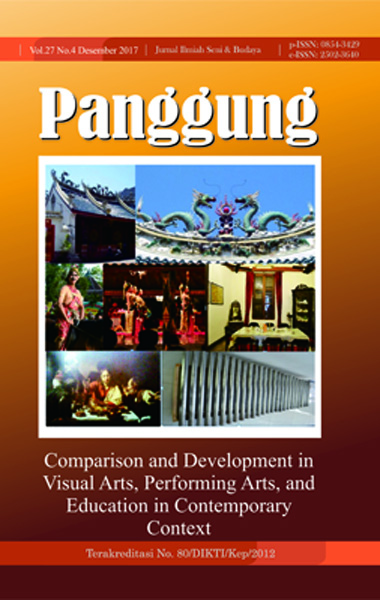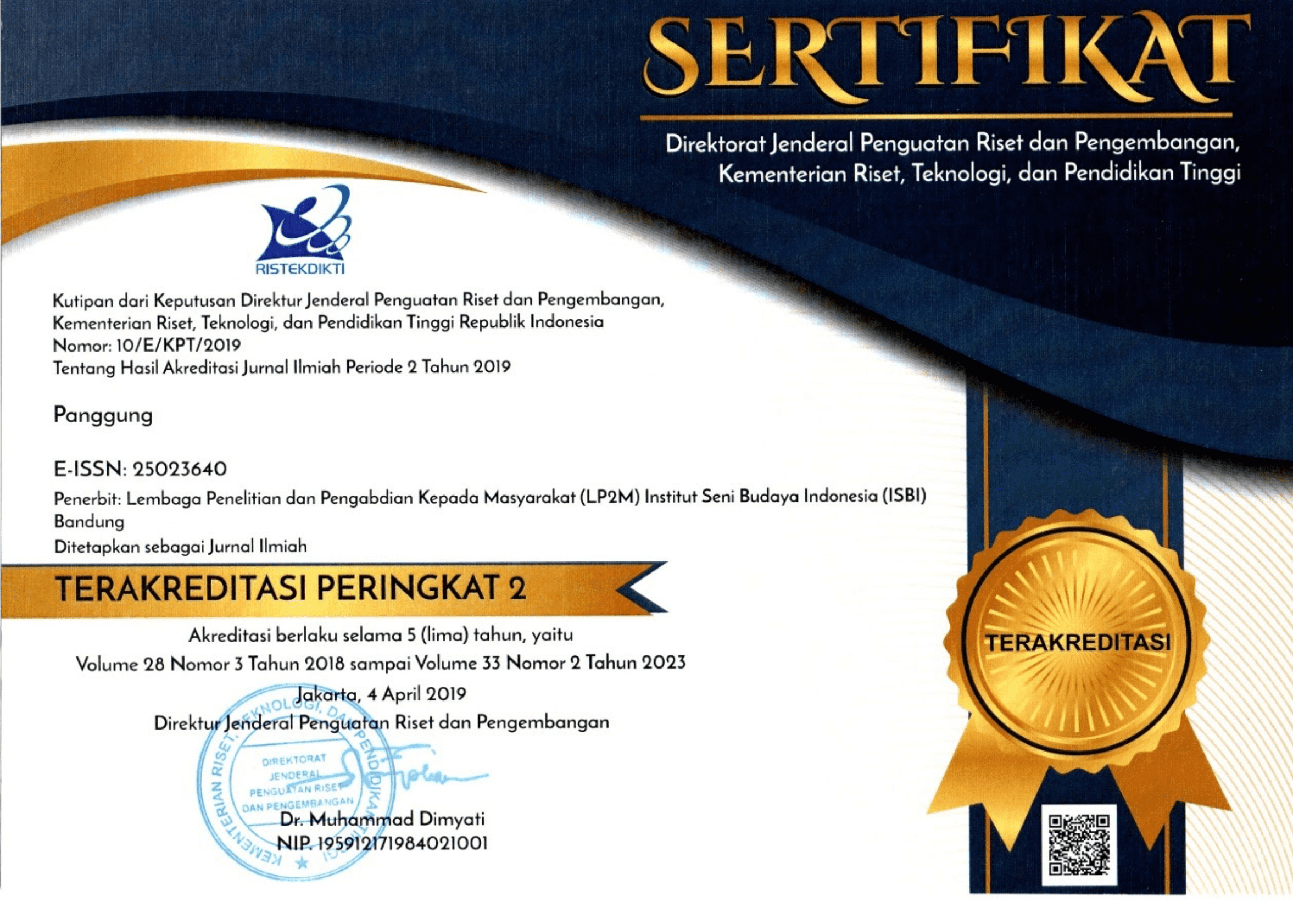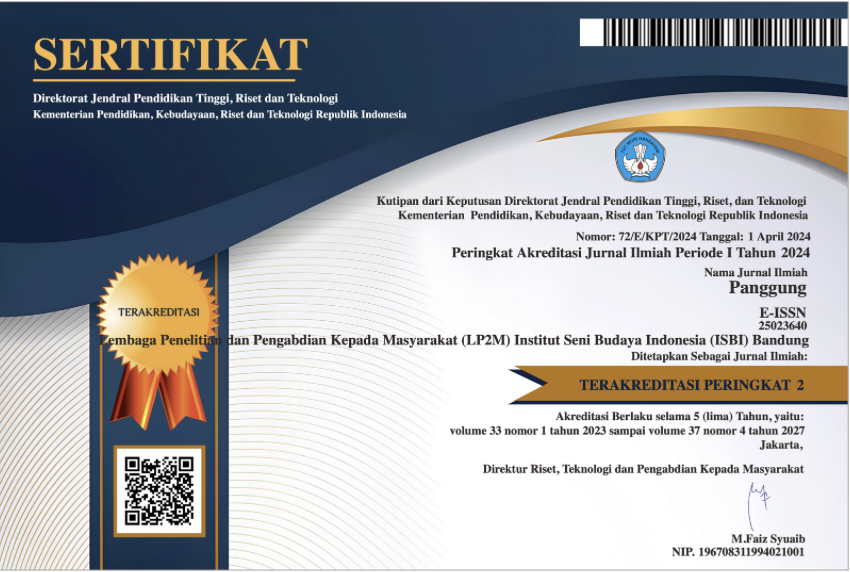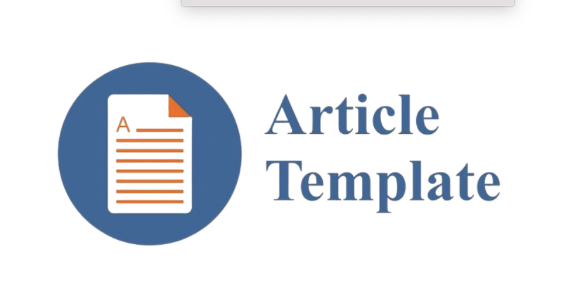The Contribution of Cultural Art in the Creation of Liong Ornament on the Roof of Tay Kak Sie Temple Semarang Central Java
DOI:
https://doi.org/10.26742/panggung.v27i4.293Abstract
Abstract
The Liong Ornaments on the roof of Tay Kak Sie Temple in Semarang Central Java are influenced by the various contributions of art and culture to its creation. The issues raised in this research, namely: 1) How Liong ornaments form on the roof of Tay Kak Sie Temple are; 2) How art elements on Liong ornaments on the roof of Tay Kak Sie Temple; 3) What are the contributions of art and culture to the creation of Liong ornaments on the roof of Tay Kak Sie Temple Semarang Central Java. The purpose of this study is to provide an explanation of Liong ornament form on the roof of Tay Kak Sie Temple; art elements on Liong ornaments on the roof of Tay Kak Sie Temple; and cultural art contribution to the creation of Liong statue ornament on the roof of Tay Kak Sie Temple Semarang Central Java. This research uses qualitative method with case study approach. Ornaments Liong statue on the roof of Tay Kak Sie Temple is a three-dimensional work with simplification and deformation techniques. Liong statue ornament is an imitative form of Chinese mythology animal. The texture of the ornament, ie smooth, smooth wavy, and rough. Liong Ornaments use seven colors and contain elements of blue monochromatic color. Liong Ornaments are included in imitative artwork with a style of naturalist expression. Expression of ornaments, namely anger, ambition, and firmness. Liong ornaments form on the roof of Tay Kak Sie Temple Semarang Central Java influenced by the factors of artists, culture, the influence of the Ming Dynasty, the location of the temple, and trust.
Keywords: Contribution of Cultural Art, Creation, Liong Ornament, Temple
References
Gie, The Liang. Filsafat Seni: Sebuah Pengantar. Yogyakarta: Pusat Belajar Ilmu Berguna, 1996.
Hartoko, Dick. Manusia dan Seni. Yogyakarta: Kanisius, 1983.
Juwono, Benny. “Etnik Cina di Surakarta 1890-1927”, dalam Lembaran Sejarah, Vol. 2 No. 1, Fakultas Sastra Universitas Gadjah Mada, Yogyakarta (1999): 62.
Kartika, Dharsono Sony. Seni Rupa Modern. Bandung: Rekayasa Sains.
Nasution, S. Metode Penelitian Naturalistik Kualitatif. Bandung: Tarsito, 1996.
Sumantra, I Wayan. “Ekspresi dan Teknik Penciptaan dalam Seni Kriya”, dalam Jurnal Institur Seni Indonesia, Denpasar (8 Februari 2010): 1-3.
Susanto, Mikke. Diksi Rupa: Kumpulan Istilah & Gerakan Seni Rupa (edisi revisi). Yogyakarta: DictiArt Lab & Djagat Art House, 2011.
Tatt, Ong Hean. Simbolisme Hewan Cina. Jakarta: Mega Poin, 1996.
Yanarko, Hari Akbar. “Terumbu Karang Sebagai Inspirasi Penciptaan Patung Deformatif”. Skripsi Program Studi Pendidikan Seni Rupa, Fakultas Bahasa dan Seni, Universitas Negeri Yogyakarta, 2012.
Downloads
Published
How to Cite
Issue
Section
Citation Check
License
Penulis yang menerbitkan jurnal ini menyetujui persyaratan berikut:
Penulis memiliki hak cipta dan memberikan jurnal hak publikasi pertama dengan karya yang secara simultan dilisensikan di bawah Creative Commons Attribution License yang memungkinkan orang lain untuk berbagi karya dengan pengakuan kepengarangan karya dan publikasi awal dalam jurnal ini.
Penulis dapat mengadakan perjanjian kontrak tambahan yang terpisah untuk distribusi non-eksklusif versi jurnal yang diterbitkan dari karya tersebut (misalnya, mempostingnya ke repositori institusional atau menerbitkannya dalam sebuah buku), dengan pengakuan atas publikasi awalnya dalam jurnal ini.
Penulis diizinkan dan didorong untuk memposting pekerjaan mereka secara online (mis., Dalam repositori institusional atau di situs web mereka) sebelum dan selama proses pengiriman, karena dapat menyebabkan pertukaran yang produktif, serta kutipan yang lebih awal dan lebih besar dari karya yang diterbitkan.
Authors who publish with this journal agree to the following terms:
Authors retain copyright and grant the journal right of first publication with the work simultaneously licensed under a Creative Commons Attribution License that allows others to share the work with an acknowledgement of the work's authorship and initial publication in this journal.
Authors are able to enter into separate, additional contractual arrangements for the non-exclusive distribution of the journal's published version of the work (e.g., post it to an institutional repository or publish it in a book), with an acknowledgement of its initial publication in this journal.
Authors are permitted and encouraged to post their work online (e.g., in institutional repositories or on their website) prior to and during the submission process, as it can lead to productive exchanges, as well as earlier and greater citation of published work.






